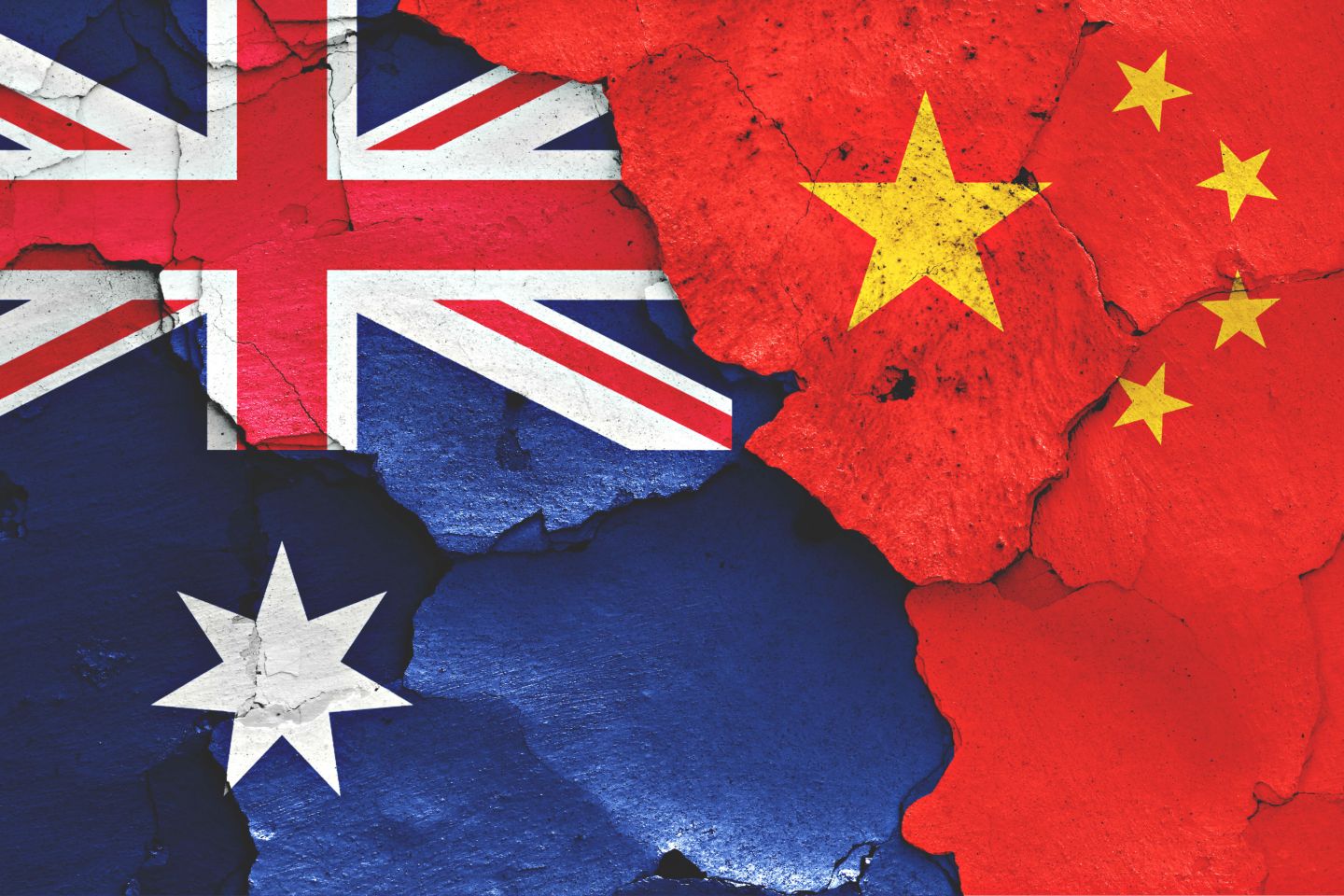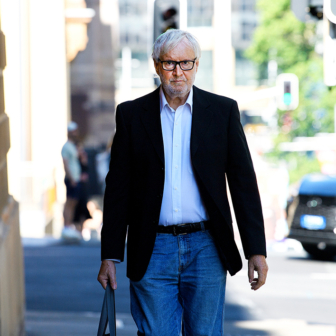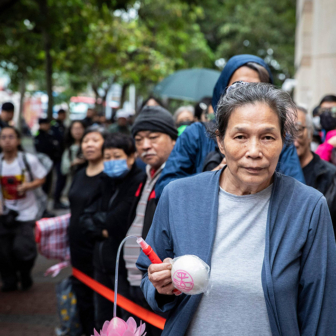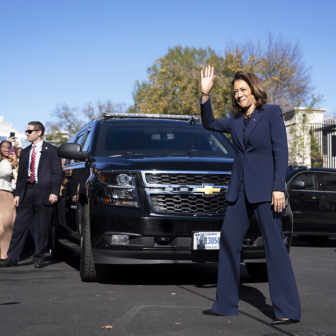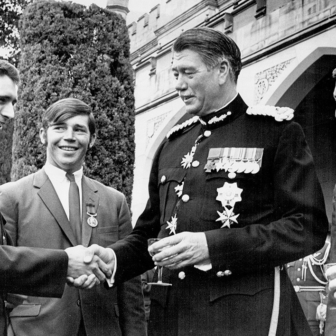A fifth icy age has descended on China–Australia relations — cooling business, frosting diplomacy and chilling strategic perspectives. China speaks of “a growing lack of mutual trust,” accusing Australia of “systematic, irresponsible, negative remarks and comments regarding China.” Australia concedes “tensions” while blaming “misunderstandings and mischaracterisations.” Australia’s former ambassador to China, Geoff Raby, sees “incoherence” in Australia’s dealings with China, judging that the relationship is at its lowest since the Tiananmen Square massacre.
Rather than incoherence, see the complexity of a relationship that now stretches across many elements of Australian life. Note a key lesson of the five icy ages: the Chinese system is always united and coherent in its proclaimed anger, while Australia debates with itself as much as it argues with China. A monolithic party in China confronts a system where the proper job of parties is to brawl; that makes icy ages messy for Australia but also strangely useful, even clarifying.
The saga of the changes in diplomatic climate begins with the foundation of the People’s Republic of China in 1949. When China stood up, Australia turned away.
First icy age (1949–72): Siding with the United States, Australia refused for twenty-three years to give diplomatic recognition to the People’s Republic. After long and arid coldness, the Whitlam government’s recognition in December 1972 created an era of warm optimism. The return of a Coalition government in 1975 made the warmth bipartisan, especially as prime minister Malcolm Fraser — a pragmatic panda-hugger — saw China as an ally in confronting the Soviet Union.
Second icy age (1989–91): Bob Hawke’s tears flowed after the Tiananmen Square massacre on 4 June 1989. Australia bashed at China, suspending ministerial visits, aid and loans and stopping military contacts. The action that had the most profound effect — and turned out to be hugely beneficial — was Hawke’s decision that Chinese students and citizens in Australia didn’t have to return to China. With family reunions added in, that saw 100,000 settling here, the biggest wave of Chinese migration since the gold rush of the mid nineteenth century.
The onset of the second icy age was sharp. Australia’s first ambassador to China, sinologist Stephen FitzGerald, said that Australia had been guilty of naive euphoria about China — “we have seemed to lose all perspective” — and argued that Tiananmen marked the end of “official intoxication with China.”
Early the following year, though, Australia’s ban on ministerial visits was lifted. China was too important to shun. Another year later, according to the Department of Foreign Affairs and Trade’s official history, the “hiatus in relations” ended in 1991. Emerging from its short pariah period, China joined APEC in 1991 simultaneously with Taiwan and Hong Kong, a moment of equivalence unimaginable today.
Third icy age (1996): China attempted to put John Howard’s government, elected in March 1996, to the sword. Ministerial visits froze and Australian businesses in China screamed that they were being punished. The new government had offended on numerous fronts. Howard’s ministers criticised Beijing’s missile-test menacing of Taiwan; Howard’s call to reinvigorate the US alliance struck Beijing as an endorsement of a containment policy. Chinese commentators fretted that Japan and Australia would be “crab claws” gripping China. The perceived Australian slights piled up: cutting aid loans, a ministerial visit to Taiwan, the PM meeting the Dalai Lama. As Howard conceded in his memoirs, it was “a rocky start.”
The thaw came when Howard met with China’s leader, Jiang Zemin, at the APEC summit in November 1996. Howard rates that conversation “as about as important a meeting as I held with any foreign leader in the time I was prime minister.” It was the start of what Howard calls one of his greatest foreign policy achievements — “the great duality” of strengthening the alliance with the United States while building an ever-closer economic relationship with China.
Howard sat down with Jiang, he recalled, “determined to focus on the things that we had in common and to put aside those things that could never be resolved between our two nations.” He told Jiang that respecting the different heritages and politics of Australia and China meant not lecturing each other: “Encouragingly, as we walked out of the meeting, the President said to me in English: ‘Face to face is much better, isn’t it?’”
Howard’s course was set. He was deeply pragmatic, conceding China’s prerogatives, promising mutual respect (in his case, respect for China’s power) and seeking to focus on trade. It worked marvellously. The China boom lifted Australia’s boat and sailed it serenely into a golden economic era.
Fourth icy age (2008–09): Beijing thought the new Mandarin-speaking leader, Kevin Rudd (Lu Kewen), understood and loved China. Trouble was, Lu/Rudd knew China’s complexity and duality and spoke truth to power.
The Rudd sharpness shaped the 2009 defence white paper. His various offerings on China were bookended by significant speeches, two years apart, in Beijing and Canberra. The Beijing University speech in April 2008, four months after taking office, was a hopeful, opening effort to dance with China. His Morrison Lecture in Canberra in April 2010, two months before he was cut down by caucus, showed signs of the frostbite caused by the fourth icy age.
In Beijing, speaking in Mandarin, Rudd offered honest criticism and sought to be a zhengyou, a true friend who “offers unflinching advice and counsels restraint” on contentious matters. He proposed “a straightforward discussion” about “significant human rights problems in Tibet.” China decided it was going to have problems with Lu Kewen.
Two years later, reflecting on the icy age, Rudd described three chilly scenarios: China as threat; China as direct competitor with the United States for control of the international system; and China as self-absorbed mercantilist bully.
In the meantime, the diplomatic pressure from Beijing had thrown up a notable document, the October 2009 Australia–China joint statement, whose ceasefire terms will be a useful template for the eventual end of hostilities in this fifth icy age. The statement came out of the bombast and official snubs dished out by Beijing in July, August and September 2009. When the row became a resolution in October, Canberra avoided the need for a symbolic kowtow and managed to get a balanced deal adorned with language about mutual respect and equality. It was the kind of diplomatic boilerplate that matters.
Here are the five paragraphs of that 2009 Australia–China statement with my added translations of the diplomatese.
- The set-up paragraph: Australia and China agreed on the “great potential and prospects” for what is described as a “comprehensive relationship.” China and Australia will promote the “long-term, sound and steady growth of the comprehensive and cooperative relationship on the basis of mutual respect, equality and mutual benefit.”
Canberra translation: We heard you yelling at us. You’ve had your say, now please consider your enduring interests — and show some respect.
- The key paragraph on the end of the conflict: “The two sides noted their different national conditions could lead to differences of one type or another. The two sides should respect and take into full consideration the core interests and major concerns of each other [and] properly handle differences and sensitive issues in accordance with the principles of mutual respect, non-interference and equality…” Australia then reiterated its one-China position on Taiwan, but more pointedly offered an explicit statement of respect for “China’s sovereignty and territorial integrity, including in relation to Tibet and Xinjiang.”
Canberra translation: No Kevin Rudd meeting with the Dalai Lama and no more visits for a while by Uighur leaders. But, as with paragraph 1: show some respect.
- The geoeconomics paragraph, covering market principles, Chinese investment and the huge benefits for each side of the trade synergies: “Recognising that the combined GDP of our two economies is greater than US$5 trillion, the two sides agreed that China and Australia enjoy strong economic complementarity, and it serves the common interests of both sides to advance economic, trade and investment cooperation on the basis of reciprocity and mutual benefit.”
Canberra translation: Your GDP is US$4.4 trillion. Our GDP is US$1.01 trillion. You’re bigger but we still count.
Also in the geoeconomics paragraph, the free-trade agreement. The negotiations were four years old. Time to try again, the statement suggests, and Australia still gets in its language about a “comprehensive, high-quality, balanced and mutually beneficial” deal.
Canberra translation: We won’t settle for the trade deal you foisted on the ASEANs, and we need a much broader deal than the Kiwis achieved. The Howard government started this agonising process so there’s not too much political pain for us if it drags on. Show some political will and kick your officials. If you’re not up to it, we’ll go elsewhere and see if Japan or South Korea can do “comprehensive and high-quality.”
Then comes the Foreign Investment Review Board bit: “The Australian side stated in clear terms that it welcomes investment from China, as China welcomes investment from Australia. Australia sees China’s increased investment interest as a positive development that will further consolidate the Australia–China economic relationship.”
Canberra translation: Read our lips: WELCOMES!
- The geopolitical clause: “The two sides agreed that China and Australia share important common interests in promoting peace, stability and development in the Asia-Pacific region.” The usual institutions get a mention: the United Nations, G20, APEC, the East Asia Summit and the Pacific Islands Forum.
Canberra translation: I won’t mention your military expansion if you don’t mention my white paper.
- The people-to-people clause: Education, culture, sports, tourism and the media.
Canberra translation: On culture and language, the Mandarin-speaking prime minister handles his own translation.
Icy periods between nations are difficult, challenging and even dangerous. Along with the perils of thrills and spills, though, chills are illuminating. The reality of the pushes, the pulls and the power plays is revealed. Differences have to be discussed, if not resolved. Dispute, not agreement, is to the fore and must be dealt with as the temperature drops.
Icy ages seldom get to a catharsis. As long as catastrophe is avoided, a rethink has its uses. Even after the let’s-move-on moment is reached (agree to disagree, or do a deal) the chill influences the future trajectory. Such periods force a reset. They do this because governments that throw the switch to cold can also recalibrate to warmer settings. That’s the positive message of history.
The fifth icy age disrupts the usual rhythms. This time the domestic dimensions of the wrangle loom large. This is more than a foreign affairs stoush — it has domestic dimensions that increase the political chill factor for both sides.
Previous icy ages tended to focus on things happening in China’s sphere. Today’s icy age has more of its action on Australian soil, because China’s sphere reaches into more Australian interests. As the balance of power moves steadily China’s way, so the blowback spills our way.
The elements of the chill — domestic and strategic — gathered last year. Australia held its tongue about Donald Trump, to hold firm to the alliance, while its language about China became shriller. Privately describing China as a “frenemy,” prime minister Malcolm Turnbull’s major Asia policy speech in Singapore in June offered a “dark view” of a “coercive China” seeking regional domination.
In November, Australia’s foreign policy white paper emphasised the friendly side of China as frenemy; that’s as it should be in an official document. Its starting point, though, is a stark fear of China’s challenge to the United States and the “rules-based” order so prized by Australia. Having described that central reality, the paper reaffirmed Australia’s seventy-seven-year commitment to the US alliance and its enduring belief in America’s role in Asia.
The domestic dimension of the cooling was dramatised in December by the fall of a Labor senator seen to be doing China’s bidding because of donations from Chinese business. Almost at the same moment, the prime minister announced legislation to ban foreign political donations and broaden the definition of espionage. To make the point in the most pointed way, Turnbull used Mandarin to quote Mao’s famous line about China standing up to state that Australia will stand against foreign interference. Chilly!
Introducing the legislation to widen the reach of foreign interference and espionage law, Malcolm Turnbull took direct aim at China in a section of his speech headed “Protecting our democracy.” Turnbull used the cover of “media reports” but the legislation is based on the government’s understanding of what China is doing. Here is how he talked about China:
Media reports have suggested that the Chinese Communist Party has been working to covertly interfere with our media, our universities and even the decisions of elected representatives right here in this building. We take these reports very seriously.
Our relationship with China is far too important to put at risk by failing to clearly set the terms of healthy and sustainable engagement. Modern China was founded by the statement that Chinese people have stood up. And today, and every day, the Australian people stand up and assert their sovereignty in our nation, with our parliament and with our laws.
As the normal customs of Oz politics apply, even in an icy age, the “stand up” line got plenty of kicks, particularly from Kevin Rudd, commenting in Mandarin on Chinese social media. “Frankly, it was irresponsible and very problematic for Turnbull to say that ‘the Australian people have stood up,’” he wrote. It was “an insult to Chinese people, to Chinese Australians, and to Australians.” In another post, he said, “I have just criticised Turnbull on Australian television because he derailed China–Australia relations for his domestic political interests. That is very irresponsible.”
A significant date in any icy age is when governments cease to deny there’s a problem and start openly discussing what’s wrong. Icy age five is now acknowledged.
China’s ambassador to Canberra, Chen Jingye, complained to the Australian about “a growing lack of mutual trust” that could hurt trade: “We have seen a kind of systematic, irresponsible, negative remarks and comments regarding China which has caused adverse impact on bilateral relations.”
Malcolm Turnbull’s version is that “tension” in the relationship is caused by “misunderstandings and mischaracterisations of our foreign interference legislation in some of the Chinese media.” Blaming the media is standard stuff in the early stage of an icy age. Once tensions are acknowledged, governments can’t wave it off as a journalistic beat-up. The “misunderstandings” line is useful for leaders feeling the freeze. The tyranny of the talking points is the need to talk, so they blame the conflict on mistake or misapprehension. Don’t believe it. No misunderstanding here.
China knows the push-pull power-play basis of this process as much as we do. In the official grievance game, Beijing is an old master. The formal expression of affront was given by China’s foreign ministry spokesperson, Hua Chunying, at her regular press conference, where she rejected the claim of Chinese interference in Australia and then ramped up to a broader charge of Australian poor faith and prejudice.
“First, with regard to political infiltration, we have responded to it on multiple occasions,” she said. “There are normal people-to-people exchanges between countries and normal exchanges and cooperation can be conducted in various fields. If one views normal exchanges as infiltration, he had better lock himself in a dark room and live in isolation. People with such a mindset should reflect on themselves.
“Second, regarding China–Australia relations, the normal and friendly exchanges and cooperation between countries should be underpinned by reliable and strong mutual trust. Without mutual trust, exchanges and cooperation in other areas would be impossible. We hope that the Australian side can make concrete efforts to discard its prejudices and discriminatory practices against China, join hands with China to step up mutual trust and create enabling conditions and a relaxing atmosphere for our exchanges and cooperation across the board.”
These are Beijing’s justifications for applying the diplomatic squeeze. You can reject its version of the dispute while accepting the twin points are a useful definition of what the icy age is about.
Australia is arguing about China’s power and role in Asia. Added to this, Australia is now arguing about China’s effort to exert power within Australia. Getting a reset on those two issues will be extremely difficult. But the rethink has started in Australia.
The icy age asks Australia to think about itself, not just about the relationship with China, as the chill blows through many Australian worlds: security, economics and trade, society, diplomacy and politics. The orbits of these worlds converge, shifting political tides and disrupting social weather.
Traditionally, dragon-slayers worry about China as a security threat, a revisionist power eating at Australia’s interests. The slayers tend to come from the security and counterespionage realm — SecWorld — but other worlds feel dragon alarms.
Panda-huggers dominate the economic realm of EcWorld. Two-way trade is worth $150 billion (more than the United States and Japan combined). The Australian’s economics writer David Uren sees it as Australia’s most intense trading relationship since dependence on Britain faded in the early 1950s: “China takes a third of our exports of goods while its students and tourists provide a quarter of our services income. China also provides more than a fifth of our imports.”
As geostrategic and geoeconomic concerns grow, gravitational wobbles make EcWorld and SecWorld snarlier and snappier, and iciness spreads to other worlds.
SecWorld has upset the usual role of the diplomats from DipWorld, according to Geoff Raby, the former deputy secretary of the Department of Foreign Affairs and Trade, who was Australia’s ambassador to China from 2007 to 2011. As China adopts “an increasingly muscular foreign policy stance” and challenges US pre-eminence, Raby writes, many in Canberra have taken fright: “In response, the Security Establishment (Defence, ONA, ASIO, ASIS, PM&C’s International Division, and the think tanks they fund such as ASPI) some time ago concluded that the China relationship was too important to trust to DFAT. The foreign minister’s, and hence her department’s, role in managing this critical relationship has become inconsequential.”
More than a Canberra turf wrestle, this is a case of worlds converging. As Raby notes, “China today permeates Australian society — some form of Chinese is the second most widely spoken language in Australian homes; fee-paying Chinese students largely support Australia’s higher education sector financially, while Chinese tourists have long been the biggest spenders. They are now also the most numerous. All of these trends will continue to deepen.”
The line about “permeates Australian society” points to that notable difference between this fifth icy age and the previous four. Much of today’s action is on Australian domestic turf — social and political — in SocWorld and PolWorld. We’re arguing about ourselves as well as China: the way we do politics, how we run and pay for universities, the life of a multicultural society. The policy issues have become personal: the 2016 census found that 2.2 per cent of Australia’s population was born in China and 5.6 per cent have Chinese ancestry.
When he introduced the foreign-influence legislation in December, Malcolm Turnbull said the focus is on foreign states and their agents, not the loyalties of Australians from a foreign country. “There is no place for racism or xenophobia in our country,” he said. “Our diaspora communities are part of the solution, not the problem.”
It was a valiant but unsuccessful attempt to keep SecWorld separate from SocWorld. But the parliamentary review of the proposed legislation, the subsequent government amendments, and the range of public submissions all show the impact on a range of Oz worlds.
They’re also evident in the clash of the petitions between two groups of Australia’s China scholars. Coming from the panda-ish side, the Concerned Scholars of China see no evidence that China aims to compromise Australian sovereignty, and disagree with key claims about Chinese influence made in support of the national security legislation:
Instead of a narrative of an Australian society in which the presence of China is being felt to a greater degree in a series of disparate fields, we are witnessing the creation of a racialised narrative of a vast official Chinese conspiracy. In the eyes of some, the objective of this conspiracy is no less than to reduce Australia to the status of a “tribute state” or “vassal.” The discourse is couched in such a way as to encourage suspicion and stigmatisation of Chinese Australians in general. The alarmist tone of this discourse impinges directly on our ability to deal with questions involving China in the calm and reasoned way they require. Already it is dissuading Chinese Australians from contributing to public debate for fear of being associated with such a conspiracy.
A dragon-ish response came from another group of scholars who say that the debate isn’t driven by “sensationalism or racism” but responds to “well-documented reports about the Chinese Communist Party’s interference in Australia.” They offered this checklist:
● Espionage and other unlawful operations by Chinese officials or their proxies on Australian soil
● Attempts to interfere in political elections
● Direct and indirect control of Chinese-language media in Australia
● Intimidation of Chinese Australians (both Australian citizens and permanent residents) for their political views and activities in Australia
● The use of political donations and agents of influence in attempts to change Australian government policies
● The takeover and co-opting of Chinese community groups to censor sensitive political discussions and increase the Chinese government’s presence in the community
● The establishment of Chinese government–backed organisations on university campuses, used for monitoring Chinese students
● Interference in academic freedom
● The cultivation of prominent Australians in attempts to sway public and elite opinion
● The covert organisation of political rallies by the Chinese government.
On the evidence of the previous three icy ages — under Hawke, Howard and Rudd — today’s chilliness will pass when both sides decide enough is enough. An icy age is a diplomatic device to inflict damage and denote displeasure. Eventually, other purposes must be served. A balance between row and kowtow will be restored.
Canberra and Beijing will have to agree on the terms of the thaw. That requires them to agree on what the argument is about. Then the leaders will meet and the language will swing from rancour and recrimination to mutual respect and shared interests.
The reset, though, will reflect a permanent change in the international weather system — the growing power of China. It will also show the many faces of China within our society. The terms of the eventual thaw will run through many Australian worlds. ●
